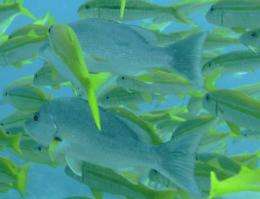Fish Sense Other Fish Via Ripples

Although humans experience their world through vision, touch and the other senses, many creatures gather information about their surroundings through unique sensory mechanisms that humans don’t have.
A new study shows how fish can "see" other fish by detecting the faint swirls cast off by fins.
For some time scientists have known that fish can detect tiny pressure changes underwater using tiny hair-like mast cells, but researchers have discovered that other cells, recessed in a series of pores, are sensitive to quick changes in pressure and can detect the swirls cast off by other fish. The incoming slight pressure gradations are combined to determine features of the source of the swirls.
In human hearing, the movement of the hair cells in the ear triggers tiny electrical signals, which are sent to the brain, where they are used to form a mental image of the sound and the source of the sound. Something like this happens when swirls strike the mast cells in a fish.
J. Leo van Hemmen and his colleagues at the Technical University of Munich and at the Institute of Zoology in Berlin are the first to work out how fish sense the swirling wakes of other fish by measuring the tiny electrical signals triggered in the mast cells, signals that last typically for only a thousandth of a second. The fish-detection scheme works for both predators and their prey.
The new results were reported in a recent issue of Physical Review Letters.
© 2009 Inside Science News Service. Used with permission.


















